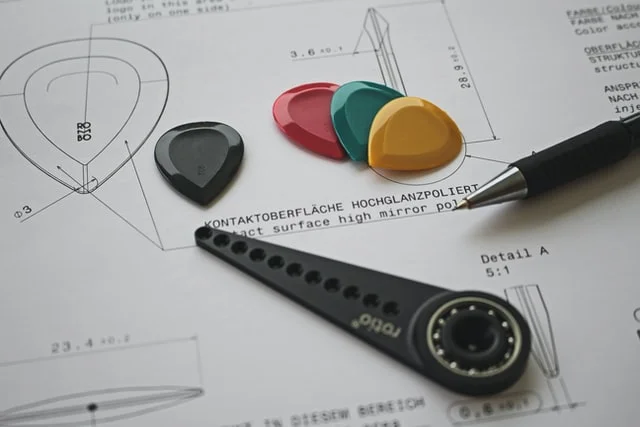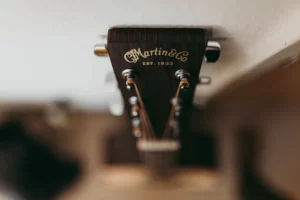This may seem abundantly clear; how to hold a guitar pick is among the important ways to learn for the earliest stages of guitarists.
What Is A Guitar Pick?
But, what would a guitar pick be, and why do you learn how to play the one? A guitar pick (also defined as a plectrum) is a triangle instrument used to ‘pick’ the electric guitars. Picks or pop devices have been used to play multiple musical instruments for hundreds of years. Since we’re speaking about modern era guitar picks to play an electric or acoustic guitar.

The manufacturing of guitar picks consists of a variety of substances. Almost all of the most well-known guitar producers sell various sizes, pressure sensors, colors, and different kinds of guitar picks. This is why, initially, selecting the best pick with you might seem immense. Even though there are genuine reasons to choose one guitar pick over another, the most critical consideration is your personal choice.
As you begin your guitar-playing journey, you might also want to attempt as many guitar picks as conceivable as possible to obtain your pick (pun intended). Fortunately, guitar picks are typically inexpensive, so you can easily purchase multiples to evaluate multiple components, control devices, and sizes; however, more pricey options are available.
If you are eager to learn some basics of guitar, please check our reviews on different types of guitars and sizes, how to choose a guitar, and the restringing of a guitar. You may check out our featured articles on Acoustic vs Electric Guitar, Classical vs Acoustic Guitar, Flamenco vs Classical Guitar, Bass vs guitar, Short Scale vs Long Scale Bass, and Ukulele vs Guitar.
How To Hold A Guitar Pick?
It may shock you to how poor technique can hinder your career in music. A stranglehold can start causing muscle cramps, whereas a weak grip would then twirl and may take off and land out of your arm.
- At first, you’ll have to buy a few guitar picks. Relatively thin picks are usually stronger for strumming, whereas thicker picks are nicer for percussion or managing rhythm and give rise to an electric guitar.
- Then there are intermediate plectrums (a 10-cent term for picks). Which are neither too versatile nor too restrictive, slipping in your fingers but not catching on the strings.
- Picks are reasonably priced, so buying a diverse range and testing with them may be worthwhile.
- When you’ve decided on your picks, ensure your strumming arm is comfortable. Placed your index and thumb around each other delicately, shut your numerous different three fingers forward into your palm.
- Easily slide the pick between the thumb and the outer boundary of an index finger so that the index finger moves down it towards the pick’s needle without protruding beyond.
Hold The Pick Strongly But Also Not Too Much So.
A sound volume of the thumb on the upper side of the pick is direct to monitor that from transferring while having fun strumming. A larger proportion of the pick appears. A far less outer pick texture can help you accurately lead single notations. It may excite you to begin now that you have your pick in hand.
When Should You Use the Pick?
You can use a guitar pick for rhythmic chord progressions strumming, playing melody and lead lines, and flexibility. Don’t use picks for mellow chord percussive instruments (broken and arpeggiated chords) and guitar solos (chords, bass, and melody combined into a single arrangement).
Which Picks Will You Be Using?
Several great guitar picks are available if you want some, and you don’t need it special when you’re just starting. Get an ultra-thin, super-flexible pick to clear the ball and forth through the strings only with minimal resistance when understanding strum chords. A classic pick would suffice to enjoy the top spot and chord progressions, but this should be bulkier, partially 1mm thick.
Guitar Pick Measurements and Shapes
Thus many people are unaware that there have been multiple kinds of guitar picks because they don’t offer them much idea. The type of guitar pick you use can impact your continuing play and tonality. Next, let’s compare the size:
Larger picks are much more effective and convenient to hold and thus are frequently used by newcomers and guitarists with a softer style of play. You wouldn’t have to be as specific due to the obvious bigger hand grip surface. Considerably larger picks are ideal for strumming chords on an electric guitar when you wouldn’t need a great deal of agility. Relatively small picks, on the other contrary, allow for greater pinpoint accuracy in your playing and thus are perfect for performers who accomplish a lot of competitive sprints, soloists, and separate notes. These are frequently metal or jazz musicians.

There are an infinite number of bizarre pick shapes and sizes, but perhaps an essential element of all of them is the exact position of the pick, which also influences the sound:
- Rounder points produce a warmer sound with a softer attack, making them ideal for strumming and sound quality.
- Sharper marks have a more unprovoked assault and are excellent for solo and high-speed players who need specificity and a vibrant tonality.
Even though there are an unlimited number of pick shapes and sizes, let’s focus on the most popular.
351 Pick Shape Standard (Standard and Sharp Tip)
The Yardstick 351 is a conventional guitar pick that will work well in certain scenarios, as the names imply. It’s popular with beginners and anybody who chooses to strum with some alternate tunings thrown into the mix. Whenever you need more specificity in your playtime, there seems to be a bigger version of the 351 with a sharp blade that will give you higher accuracy.
Pick Shape: Spiky or Strong
These would be comparable to standard 351 picks, but unlike classic picks with soft, rounded corners, sharply pointed picks possess plain and strong edges. The creation of a tip will give you more high accuracy when picking separate strings, will be the same. They are, however, much less spectacular unless your playing encompasses a wide range of strumming.
Triangular Pick Form
This pick form is less popular than in the first 2 and is primarily used among bluegrass musicians. They are equally effective while playing riffs or separate notes. However, since they are bigger than most of pick kinds, they are much less best suited for even more combative musical styles.
Shark Fin Pick Form
Shark fin picks to get a different appearance; however, what makes them much more intriguing would be that in furthermore to the spot, they get one margin upon which to pick the strings. The edge nearly appears serrated, and the small streams help to create various soundtracks as they strike the strings. The needle is rounded, which makes it suitable for strumming.
Jazz III Pick Form
Even though these have been designed to be used against jazz musicians. They are also popular between many steel guitarists and crushers. Their shape allows players to perform with fantastic precision and efficiency. Jazz III picks seem heavier and tinier than most other picks, making each other more durable.
Teardrop Pick Form (Thin and Wide)
Teardrop picks are available in two sizes: thin and wide. All of these are variations on the Jazz III pick previously mentioned. The thin teardrop is much less satisfied but provides more high accuracy and influence. While the broad teardrop is much more pleasant but has a gentler attack.
Description Of Sizes And Thicknesses Of Plectrums
It means a lot if it is important to you. All kidding aside, guitar pick thickness does make much difference, especially for beginners, because this can obtain a better tonality.
A few players would also prefer the sense of a relatively thick pick and assume us when we say that comfort is important when playing or learning for hours and hours.
Thin picks, in general, are stronger only when you strum a lot. And if you want a tightened vibrant and much less volume. They also have the potential to pull out nicer tones.
Thick picks are nicer for profound, gentler tones because they bring out all the acoustic guitar tones. And also if you want a broader contrast ratio, crisper attack, and much more volume.
They are suitable for electric instrumentalists who enjoy quick passes and soloists. Because their surface area helps make each other more durable.
The following are the various guitar pick thicknesses:
- Lightweight (under 0.40 mm)
- (0.40 mm – 0.63 mm) light
- (0.63 mm – 0.85 mm) medium
- (0.85 mm – 1.22 mm) thick
- Extra heavy (1.22+ mm)
Conclusion
If you’re really beginning out, among the most important techniques to learn is how to hold a guitar pick. Eventually, you successfully improved your finger strategizing as a result of this guide and managed to find the tips useful. If you want to put a new hold through its paces with some wonderful rhythms, read this article carefully.
Tell Us What You Think – We would love to hear your comments and questions. What specific things are you struggling with while learning guitar?







